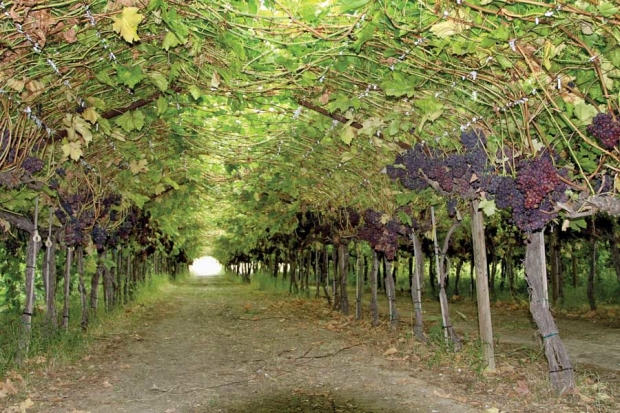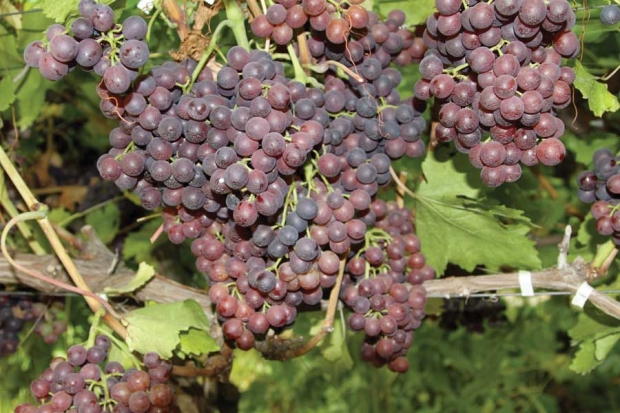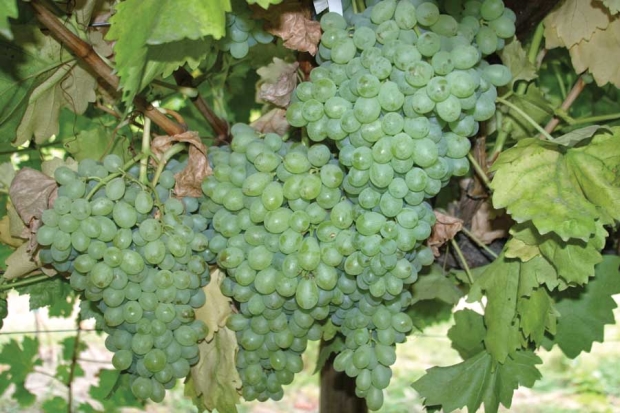
The quadrilateral training system has been a successful canopy style for Alborz grapes in Idaho. (Courtesy Essie Fallahi, University of Idaho)
Idaho’s burgeoning table grape industry, poised for great things, needs a nudge before additional expansion takes place. Industry members hope a new research grant will take the industry to the next level.
More than two decades ago, University of Idaho’s Dr. Esmaeil Fallahi showed local growers that table grapes could thrive in southwestern Idaho.
His initial research trials identified varieties suitable for the Treasure Valley, an area west of Boise where most of the state’s tree fruit and wine grapes are grown.
Since then, several hundred acres of table grapes have been planted in the Intermountain West region of Idaho and neighboring states, and progress has been made in developing a new industry.
But growers believe the newest round of Fallahi’s research, made possible by a 2015 specialty crop block grant from the Idaho State Department of Agriculture, is what’s needed to take the industry to the next level.
The $163,000 grant significantly expands Fallahi’s research and allows him to test new table grape selections and study canopy management and training systems as he works to increase yields and improve quality parameters of fruit and cluster size.
“There’s a tremendous amount of interest and activity in table grapes right now,” said Tom Elias, founding member of what’s now called the Snake River Table Grape Growers Association, a group that renamed itself to align with Idaho’s first wine grape appellation, the Snake River Valley American Viticultural Area.
Elias, past president of the grower group, grows table grapes and Asian pears near Marsing, Idaho. He also provides table and wine grape plant material to other growers.
While Elias couldn’t give a definitive number of table grape acres in Idaho, he told Good Fruit Grower the number is “more than a hundred and less than a thousand.”
Though a few vineyards have been removed in recent years because they were in the wrong location or the grower wasn’t prepared for the amount of work involved, according to Elias, table grape acreage of late is on the upswing. He cited several 20-acre blocks recently planted and said there’s planting interest from drought-stricken grape growers in California who are searching for ground with water.
(Even though there was a lack of snowfall in the Pacific Northwest this past year, Elias had enough surface water to grow his grapes and has the option of pumping groundwater.)
Table grape harvest in Idaho starts in September and continues into October. “It’s late enough to avoid overlap with California,” said Elias.
“Our timing is perfect — we’re after most California table grapes are harvested but before imported Chilean grapes arrive in November. Most of the California grapes sold in our time frame are coming out of cold storage.”
Convert
The current president of the Idaho table grape growers group, Kevin Schultz, is a recent convert to Idaho’s table grape industry and represents a new generation of growers. At 37, he’s much younger than other table grape growers who planted small vineyards to keep them busy in retirement.
“I have a business background, so I see things from a different perspective than some of the older growers,” Schultz said. “When I analyze the profitability of growing table grapes in Idaho, I see amazing revenue potential.”
He planted 20 acres of table grapes in Eagle last year for Dry Creek Grapes LLC, and the partnership has another 200 acres of table grapes planted near Emmett.
Schultz believes the local food movement is a key reason why Idaho table grapes can be profitable and compete with California. Large and small grocers are promoting the origins of local fruits and vegetables.
New varieties
Fallahi, pomologist at UI’s research and extension center in Parma, shares the enthusiasm of Elias and Schultz. “There’s a lot of excitement in the industry right now,” he said. In the right location, growers can produce good quality fruit.
However, he warned that growers must be mindful of their grapevines’ cold hardiness. “Avoid planting table grapes in cold pockets — save those spots for shop buildings or other crops — and be ready to cut off irrigation early, especially in young vineyards, to help vines go into winter dormancy.”
The research grant allows Fallahi to greatly expand his varietal research by adding more than 15 new selections to his variety trials, some from California’s Sheehan Genetics, a private California company developing new varieties from the breeding program of the late Tim Sheehan.
Fallahi hopes the new generation of red and green seedless table grapes will result in new and improved cultivars better suited to Idaho’s growing conditions.

Alborz is the main commercial table grape variety in the U.S. Intermountain west region.
(Courtesy Essie Fallahi, University of Idaho)
For example, the main cultivar grown in the state is Alborz, a variety similar to Flame Seedless. Fallahi wants to find a red seedless cultivar similar to Alborz, but with better cold hardiness. Jupiter, a blue-colored grape has a following in Taiwan, but it produces small clusters.
The green seedless Emerald variety is productive but susceptible to powdery mildew.

The Emerald table grape variety is a large, yellow-green, mid-season grape. (Courtesy Essie Fallahi, University of Idaho)
California table grape varieties typically don’t do well in Idaho because they are not cold tolerant. Varieties currently planted have come from several breeding programs, including the University of Arkansas, Cornell University and Australia.
A major focus of Fallahi’s expanded research is to improve cluster and fruit size through training and canopy management. He plans to compare vines trained to single, double and quadrilateral cordons and will vary the numbers of clusters per vine to manipulate yield and fruit and cluster size.
Awareness
Schultz believes there’s a lack of awareness of the state’s potential as a viable area for the table grape industry.
While a few growers are making gains in wholesale markets—Elias sells his grapes to markets in Canada and Alaska, and another grower is exporting table grapes to Taiwan—more work is needed to identify improved varieties, elevate fruit quality and expand the industry to develop critical mass.
“We need a couple of flagship growing operations to put Idaho table grapes on the map, and I hope one is mine,” said Schultz. “I’d like to be the poster child that helps bring awareness and publicity to Idaho’s table grape industry.” •
– by Melissa Hansen






Where can I find a nursery that sells Alborz grape vines? I have searched and unable to find one.
Thanks so much. Donna